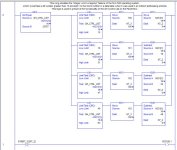Hi everyone, I'm in need of your help. i have attached two images of the same logic, one in 500 and the other one in logix5000. this is data coming from a panelview terminal used manipulate valves. we have 60 valves in the panelview each one has a value that goes into n231[1] number range from 0-59 representing consecutive bits in B16:100 to B16:103
N231[1] is a value coming from the PV which represent a valve a motor or pump. this is used to force the bit. so if the operator select V05 the panelview passes a value of 54
that value is then moved to N7[2].
on the next rung we have have B16:100/[7:2] in the old logic(SLC). so what it was doing was the following. it was putting a 54 there and instead of going into B16:100 it went to
B16:103/6 and put a 1 in that bit. so essentially it uses the integer n7[2] to point thru the array of b16 starting in 100 and it move 54 bits and selects the bit. this works perfect on the SLC, but on the Controllogix it does not poin to the B16[103].6 .
what it does instead, it's the following it puts a 54 as value in B16[100].[N7_2] which ends up faulting the processor immediately. so right now this is stopping me from using the panelview terminal which is is a problem.
what i need is a way to make the logic work on the Controllogix so if anybody knows i would appreciate the help.
In the 5000 all data involve in this logic are INT.
Thank you in advance


N231[1] is a value coming from the PV which represent a valve a motor or pump. this is used to force the bit. so if the operator select V05 the panelview passes a value of 54
that value is then moved to N7[2].
on the next rung we have have B16:100/[7:2] in the old logic(SLC). so what it was doing was the following. it was putting a 54 there and instead of going into B16:100 it went to
B16:103/6 and put a 1 in that bit. so essentially it uses the integer n7[2] to point thru the array of b16 starting in 100 and it move 54 bits and selects the bit. this works perfect on the SLC, but on the Controllogix it does not poin to the B16[103].6 .
what it does instead, it's the following it puts a 54 as value in B16[100].[N7_2] which ends up faulting the processor immediately. so right now this is stopping me from using the panelview terminal which is is a problem.
what i need is a way to make the logic work on the Controllogix so if anybody knows i would appreciate the help.
In the 5000 all data involve in this logic are INT.
Thank you in advance







